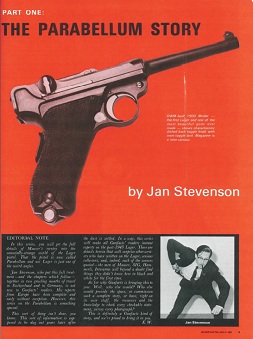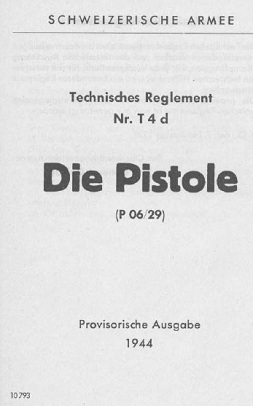The Luger selfloading pistol is one of the most iconic handguns ever designed, and has been very successful despite a rather archaic operating mechanism.
Georg Luger worked as an employee at Ludwig Loewe & Co, where Hugo Borchardt’s C93 pistol was manufactured. He took the toggle locking design somewhat clumsily used in the Borchardt and redesigned it to use a small leaf spring in the pistol’s grip instead of a clock-type spring in a separate housing. This allowed Luger to dramatically reduce the bulk of the gun, and make it much more practical as a military sidearm. The mechanism uses the same recoil action employed by other early autopistols, but instead of using a bolt to travel directly backwards the Luger used a toggle joint. This would lock solid when laying flat, but once the recoiling barrel cammed it slightly upwards at the joint it would open up to eject the spent casing and load a fresh one.
There are many available sources for excellent information on the Luger, so we will try to focus on some of the more esoteric varieties here.
Manuals
Photos
A small handful of pictures of a prototype Japanese Luger. The characters on the left read “Tokyo Gas Electric Company Ltd” and on the right “Test Purpose Pistol”. It also has markings for “fire” and “safe” for the safety lever, and none of the typical proof marks. (Download gallery in high resolution)
[nggallery id=101]
Patents
US Patent #753,414 (G. Luger; Recoil Loading Small Arms; March 1, 1904)
Resources
This 5-part article details to effort of the Mauser company to produce new manufacture Luger pistols on 1970, with lots of very interesting details on production methods. Click to download in PDF format.



That Japanese Luger Prototype is one beautiful crisp looking gun. I’ll bet there’s less of those than the 45 cal Luger’s out there. Is it a museum piece?
Interesting…The “prototype Japanese Luger” has a DWM logo on the toggle…So it’s not a prototype made *by* the Japanese, but *for* the Japanese…
Luger is one of my favorite designs !
You’ve included a patent…I like it !!! Most of patents include useful info that one can’t find in manuals or elsewhere !
Amazing! And made for the IJN, as the small acceptance mark on the right side of the pistol and the naval badge in the usual place for national coat-of-arms seem to imply. Thanks for posting such beautiful pictures of a very, very rare Luger prototype I was totally unware of!
A friend of mine, grandfather had an impressive gun collection. 200+ hand guns, and Just as many rifles… but he traveled the world over in the 1920 the late 1970’s. He had a Imperial Russian, contact Luger…. in .30 Luger. It had all of the DWM Proofs, and then it had The Imperial Russian Eagle, and a set of crossed rifles with the number 15 (A Guards unit no.15). He also had the holster, funny thing that holster… it was Russian made… it looked like a Nagant Revolver holster. His home was broken into, and just about everything was stolen, and that was 10 years ago. SLOWLYYYYYYYYYYYYYYYYYYYYYYYYY! Stuff is coming back to him.
I would like to have one of the Artillery .45s they made for the American Army tests.
There have been several people building .45 ACP Lugers over the years. One guy cut two guns apart, off center and the welded the larger halves together to make one 45 ACP. I shot one of these back in the early ’70s, but could not afford it. He wanted over $1,000 for it back then and my .44 Automag only cost $247 brand new at the same time. But that was a bunch of money back then too.
Some other guy used CNC machining to make new guns, but went out of business in the Carter Depression, IIRC.
The thing I remember about the Lugers I’ve shot is that the trigger was particularly susceptible to dirt and grit getting between the frame and draw bar making the pull hard and uneven. Making them hard to shoot well when dirty, or in field conditions.
When I was about 10 years old, a family friend had ‘stashed’ an old Luger in our house.
No one knew it was there but me and my older brother when we found it in the crawl-space.
We unloaded it [round in chamber, of course] then proceeded to take it apart.
All the way down to the tiny pins and springs in the frame. We were thorough.
The parts got scattered all over the neighborhood, all except the magazine.
We gave it to our Mom, and she gave it back to him. Never saw him again.
Now the sad part: manufacturer date 1928.
It was in near perfect condition: gorgeous bluing, checkering on grip was still ‘crisp’.
We were little monsters, I guess.
Erfurt 1917 selective mode (full/semi) P-08 variant.
I have a review published in a French magazine regarding a prototype selective mode P-08.
Let me know if you are interested – I could email it after scanning it. I also would not mind translating it into English.
Regards
Yes, I would definitely be interested in seeing that article – thanks!
Just give me an email address and you got it.
admin@forgottenweapons.com
Just sent you better resolution color scan.
Let me know if you are interested in translation to English.
Regards
I too saw a .45 Luger that Mr. John Martz made up from two Luger pistols and it was BEAUTIFUL. I would like to have had it but it was beyond my capability at that time. I did have Mr. Martz build a Luger carbine with a 9 mm,12″ barrel for me from a 1937 S/42 mis-matched Luger I had at the time. That is one BEAUTIFUL piece. It shoots to point of aim at 50 yards. It is one of my prized items in my 15 piece Luger collection.